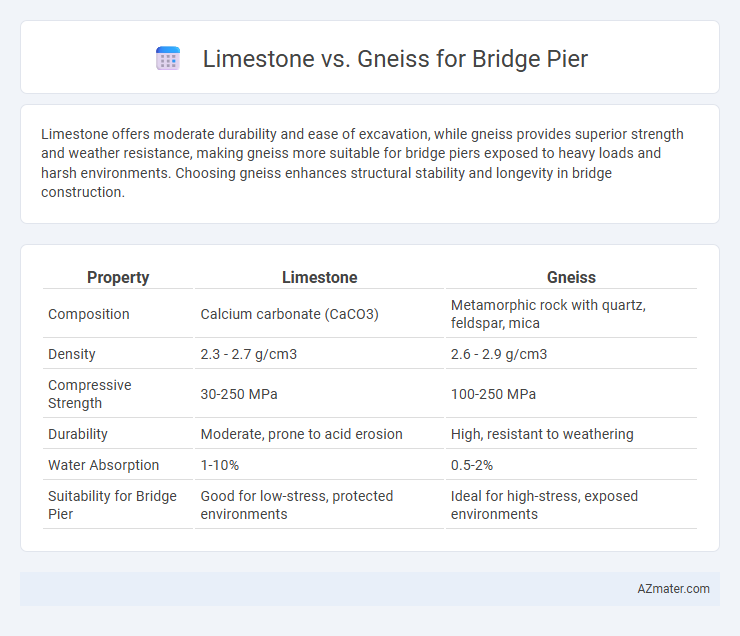Limestone offers moderate durability and ease of excavation, while gneiss provides superior strength and weather resistance, making gneiss more suitable for bridge piers exposed to heavy loads and harsh environments. Choosing gneiss enhances structural stability and longevity in bridge construction.
Table of Comparison
| Property | Limestone | Gneiss |
|---|---|---|
| Composition | Calcium carbonate (CaCO3) | Metamorphic rock with quartz, feldspar, mica |
| Density | 2.3 - 2.7 g/cm3 | 2.6 - 2.9 g/cm3 |
| Compressive Strength | 30-250 MPa | 100-250 MPa |
| Durability | Moderate, prone to acid erosion | High, resistant to weathering |
| Water Absorption | 1-10% | 0.5-2% |
| Suitability for Bridge Pier | Good for low-stress, protected environments | Ideal for high-stress, exposed environments |
Introduction: The Importance of Stone Selection for Bridge Piers
Selecting the appropriate stone for bridge piers ensures structural integrity and longevity under varying environmental conditions. Limestone offers ease of shaping and a uniform appearance but may lack the compressive strength and durability found in gneiss. Gneiss provides superior hardness, weather resistance, and load-bearing capacity, making it a preferred choice for critical bridge pier applications.
Overview of Limestone and Gneiss
Limestone is a sedimentary rock primarily composed of calcium carbonate, known for its moderate strength and ease of quarrying, making it commonly used in construction where durability is essential. Gneiss, a high-grade metamorphic rock, features a foliated texture and superior strength and weather resistance, ideal for structural applications requiring enhanced load-bearing capacity. Both rocks offer unique advantages for bridge piers, with limestone providing cost-effective workability and gneiss delivering higher mechanical performance and longevity.
Geological Formation and Composition
Limestone, primarily composed of calcium carbonate, forms through sedimentary processes involving the accumulation of marine organisms' skeletal fragments, making it relatively porous and susceptible to chemical weathering. Gneiss, a metamorphic rock formed under high temperature and pressure conditions, exhibits a banded texture with minerals like quartz, feldspar, and mica, resulting in superior strength and durability. For bridge piers, gneiss offers enhanced resistance to mechanical stress and weathering compared to the more chemically reactive and softer limestone.
Physical Properties: Strength and Durability
Limestone, characterized by moderate compressive strength typically ranging from 30 to 250 MPa, offers ease of shaping but exhibits lower durability under acidic conditions and freeze-thaw cycles compared to gneiss. Gneiss, a high-grade metamorphic rock with compressive strength often exceeding 100 MPa and pronounced foliation, provides superior durability, resistance to weathering, and structural stability essential for bridge pier applications. The dense, crystalline structure of gneiss results in enhanced load-bearing capacity and longevity, making it a preferred choice over limestone where strength and durability are critical.
Weathering and Resistance to Water
Limestone exhibits moderate weathering resistance but is more prone to chemical erosion and dissolution when exposed to acidic rain and flowing water, which can weaken bridge piers over time. Gneiss offers superior durability and resistance to weathering due to its tightly interlocked mineral grains and low porosity, enhancing its ability to withstand water infiltration and freeze-thaw cycles. When selecting materials for bridge piers, gneiss provides greater longevity and structural integrity in environments with high moisture and fluctuating weather conditions.
Workability and Ease of Construction
Limestone offers superior workability for bridge pier construction due to its relatively softer texture, allowing easier cutting, shaping, and drilling compared to gneiss. Gneiss, characterized by its high density and hardness, poses challenges in machining and requires specialized equipment, increasing construction time and labor costs. Selecting limestone can streamline the construction process, enhancing efficiency and reducing overall project expenses.
Cost Considerations and Availability
Limestone is generally more cost-effective for bridge piers due to its widespread availability and lower quarrying expenses compared to gneiss, which often involves higher extraction and processing costs. Limestone deposits are abundant in many regions, reducing transportation expenses and making it a budget-friendly choice for large-scale construction projects. Gneiss, although stronger and more durable, may increase project costs due to limited local availability and higher logistical challenges.
Environmental Impact and Sustainability
Limestone exhibits moderate environmental impact due to its quarrying process, which can lead to habitat disruption and significant CO2 emissions from calcination, but it is highly recyclable and often sourced locally, reducing transportation emissions. Gneiss, a metamorphic rock, generally requires less processing energy and offers superior durability and longevity for bridge piers, resulting in lower lifecycle environmental costs and reduced need for frequent repairs or replacements. Selecting gneiss contributes to sustainable infrastructure by minimizing resource extraction impacts and enhancing structural resilience under environmental stress.
Case Studies: Limestone vs Gneiss in Bridge Engineering
Case studies comparing limestone and gneiss for bridge piers highlight gneiss's superior durability and resistance to weathering in high-stress environments, leading to longer structural lifespan and reduced maintenance costs. Limestone, while easier to quarry and shape, often exhibits higher porosity and susceptibility to chemical erosion, which can compromise the stability of bridge foundations in acidic or wet conditions. Engineering evaluations from multiple projects demonstrate that gneiss pier foundations consistently outperform limestone under dynamic loads and riverine erosion, making it the preferred choice for critical bridge infrastructures.
Conclusion: Choosing the Best Stone for Bridge Piers
Limestone offers moderate strength and ease of shaping but is more prone to weathering and erosion compared to gneiss, which provides superior durability and resistance due to its dense, foliated structure. Gneiss's high compressive strength and low permeability make it the optimal choice for bridge piers exposed to harsh environmental conditions and heavy loads. Selecting gneiss ensures enhanced longevity and structural integrity for bridge piers in demanding engineering applications.

Infographic: Limestone vs Gneiss for Bridge Pier
 azmater.com
azmater.com